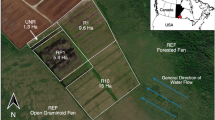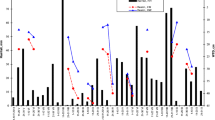Abstract
Peatlands are abundant in the boreal region of Canada but little is known about their restoration on oil sands well pads. The goal of this study is to compare the reintroduction of different peatland plant communities and substrate amendments/decompaction in order to rehabilitate peatland vegetation on former in situ well pads constructed in wetlands. One field experiment tested which peatland plant communities (Shrubby Rich Fen, Treed Rich Fen) would best colonize different substrates (sawdust, clay loam, mix sawdust-clay, peat, surface roughness). We found that the moss layer transfer technique (MLTT) facilitated the establishment of peatland communities on residual mineral soil used to construct the pad, when shaved back to an average water level of the surrounding wetland. The choice of peatland plant community is key to the introduction of bryophytes. Peat amendment facilitated the establishment of plants, whereas soil decompaction had no effect. The MLTT is a promising approach to restore fen plants on well pads. We recommend a scale-up experiment for a whole well site to test the validity of MLTT along different pad removal techniques.



Similar content being viewed by others
Change history
28 May 2018
In the original publication, the Table 1 was published incorrectly. The correct version of Table 1 is given in this correction. The original article has been corrected.
References
Amacher MC, Henderson RE, Breithaupt MD, Seale CL, LaBauve JM (1990) Unbuffered and buffered salt methods for exchangeable cations and effective cation-exchange capacity. Soil Sci Soc Am J 54:1036–1042
Amon JP, Jacobson CS, Shelley ML (2005) Construction of fens with and without hydric soils. Ecol Eng 24:341–357
Averett JM, Robert AK, Lucas NE, Frey SD, Curtis P (2004) Effects of soil carbon amendment on nitrogen availability and plant growth in an experimental tallgrass prairie restoration. Restor Ecol 12:568–574
Bainbridge DA (2007) A guide for desert and dryland restoration: new hope for arid lands. Island Press, Washington DC
Bates JW (2009) Mineral nutrition and substratum ecology. In: Goffinet B, Shaw AJ (eds) Bryophyte biology, 2nd edn. Cambridge University Press, Cambridge, pp 300–356
Borkenhagen A, Cooper DJ (2016) Creating fen initiation conditions: a new approach for peatland reclamation in the oil sands region of Alberta. J Appl Ecol 53:550–558
Brouillet L, Coursol F, Meades SJ, Favreau M, Anions M, Bélisles P, Desmet P (2010+) VASCAN, the database of vascular plants of Canada. http://data.canadensys.net/vascan/vernacular/25478. Accessed 12 Oct 2016
Bulmer C (2000) Reclamation of forest soils with excavator tillage and organic amendments. For Ecol Manag 33:157–163
Buykx SEJ, van den Hoop MAGT, de Joode P (2004) Simultaneous extraction of bromide, chloride, fluoride and sulfate from soils, waste- and building materials. J Environ Monit 6:552–558
Campeau S, Rochefort L, Price J (2004) On the use of shallow basin to restore cutover peatlands: plant establishment. Restor Ecol 12:471–482
Chee WL, Vitt DH (1989) The vegetation, surface water chemistry and peat chemistry of moderate-rich fens in central Alberta, Canada. Wetlands 9:227–261
Cobbaert D, Rochefort L, Price JS (2004) Experimental restoration of a fen plant community after peat mining. Appl Veg Sci 7:209–220
Cooper DJ, MacDonald LH (2000) Restoring the vegetation of mined peatlands in the southern Rocky Mountains of Colorado, USA. Restor Ecol 8:103–111
Cooperband L (2002) Building soil organic matter with organic amendments. Center for Integrated Agricultural Systems (CIAS), College of Agricultural and Life Sciences, University of Wisconsin-Madison, Madison
Curtis MJ, Claassen VP (2009) Regenerating topsoil functionality in four drastically disturbed soil types by compost incorporation. Restor Ecol 17:24–32
Davis S (1990) Effectiveness of a winged subsoiler in ameliorating a compacted clayey forest soil. West J Appl For 5:138–139
Eldridge JD, Redente ED, Pasche M (2012) The use of seedbed modifications and wood chips to accelerate restoration of well pad sites in Western Colorado, U.S.A. Restor Ecol 20:524–531
Environment Canada (2012) Canadian climate normals: 1981–2010 climate normals & averages. http://climate.weatheroffice.gc.ca/climate_normals/. Accessed 21 Jul 2012
Environment and Parks (2015) Reclamation criteria for wellsites and associated facilities for peatlands. Environment and Parks, Edmonton, p 142
Fetter CM (2001) Applied hydrogeology, 4th edn. Prentice Hall, Upper Saddle River
Flora of North America Editorial Committee, eds. (1993+) Flora of North America North of Mexico. 20+ vols. New York and Oxford
González E, Rochefort L (2014) Drivers of success in 53 cutover bogs restored by a moss layer transfer technique. Ecol Eng 68:279–290
Gorham E, Janssens JA (1992) Concepts of fen and bog re-examined in relation to bryophyte cover and the acidity of surface waters. Acta Soc Bot Pol 61:7–20
Graf M, Rochefort L (2008) Techniques for restoring fen communities on cut-away peatlands in North America. Appl Veg Sci 11:521–528
Graf M, Rochefort L (2009) Examining the peat-accumulating potential of fen vegetation in the context of fen restoration of harvested peatlands. Écoscience 16:158–166
Graf M, Rochefort L (2010) Moss regeneration for fen restoration: fields and greenhouse experiments. Restor Ecol 18:121–130
Graf M, Rochefort L (2016) A conceptual framework for ecosystem restoration applied to industrial peatlands. In: Bonn A, Allott T, Evans M, Joosten H, Stoneman R (eds) Peatland restoration and ecosystem services: science, policy and practice. Ecological Reviews of Cambridge University Press, Cambridge, pp 192–212
Groeneveld EVG, Massé A, Rochefort L (2007) Polytrichum strictum as a nurse-plant in peatland restoration. Restor Ecol 15:709–719
Hugron S, Poulin M, Rochefort L (2013) Organic matter amendment enhances establishment of reintroduced bryophytes and lichens in borrow pits located in boreal forest highlands. Boreal Environ Res 18:317–328
Instruments Lachat (2012) Methods list for automate ion analyzers. Flow Injection Analysis Ion Chromatography. Loveland, CO, p 64
Järveoja J, Peichl M, Maddison M, Soosaar K, Vellak K, Karofeld E, Teemusk A, Mander Ü (2016) Impact of water table level on annual carbon and greenhouse gas balances of a restored peat extraction area. Biogeosciences 13:2637–2651
Larney FJ, Angers DA (2012) The role of organic amendments in soil reclamation: a review. Can J Soil Sci 92:19–38
Li Y, Vitt DH (1994) The dynamics of moss establishment: temporal responses to nutrient gradients. Bryologist 97:357–364
Mahmood MdS, Strack M (2011) Methane dynamics of recolonized cutover minerotrophic peatland: implications for restoration. Ecol Eng 37:1859–1868
Malmer N (1986) Vegetational gradients in relation to environmental conditions in northwestern European mires. Can J Bot 64:375–383
Mälson K, Rydin H (2007) The regeneration capabilities of bryophytes for rich fen restoration. Biol Conserv 135:435–442
McNabb DH, Sobze J-M, Schoonmaker A (2012) Tilling compacted soils with RipPlows: A disturbed soil restoration technique. NAIT Boreal Research Institute, Alberta, Technical Note, November 2012 (http://www.nait.ca/docs/1_Tilling_Compacted_Soil_with_RipPlow.pdf)
Morgan JP (1994) Soil impoverishment: a little-known technique holds potential for establishing prairie. Restor Manag Notes 12:55–56
Osko T (2010) Gap analysis of wetland reclamation knowledge and practices in Northern Alberta. Circle T Consulting Inc., Vegrevill. CEMA Contract No. 2008-0024
Patzelt A, Wild U, Pfadenhauer J (2001) Restoration of wet fen meadows by topsoil removal: vegetation development and germination biology of fen species. Restor Ecol 9:127–136
Pfadenhauer J, Grootjans A (1999) Wetland restoration in Central Europe: aims and methods. Appl Veg Sci 2:95–106
Polster DF (2009) Natural processes: the application of natural systems for the reclamation of drastically disturbed sites. B.C. Technical and Research Committee on Reclamation, BC Mine Reclamation Symposium. Cranbrook, 14–17 September 2009
Pouliot R, Rochefort L, Graf MD (2013) Fen mosses can tolerate some saline conditions found in oil sands process water. Environ Exp Bot 89:44–50
Pouliot R, Hugron S, Rochefort L (2015) Sphagnum farming: a long-term study on producing peat moss biomass sustainably. Ecol Engin 74:135–147
Price JS, Whittington PN (2010) Water flow in Sphagnum hummocks: mesocosm measurements and modelling. J Hydrol 381:333–340
Quinty F, Rochefort L (2003) Peatland restoration guide, 2nd edn. Canadian Sphagnum Peat Moss Association and New Brunswick Department of Natural Resources and Energy, Québec
Reid NB, Naeth MA (2005) Establishment of a vegetation cover on tundra Kimberlite mine tailings: 2. A field study. Restor Ecol 13:602–608
Rezanezhad F, Andersen R, Pouliot R, Price JS, Rochefort L, Graf MD (2012) How fen vegetation structure affects the transport of oil sands process-affected waters. Wetlands 32:557–570
Rochefort L, Lode E (2006) Restoration of degraded boreal peatlands. In: Wieder RK, Vitt DH (eds) Boreal peatlands Ecosystems, ecological studies series 188. Springer-Verlag, Berlin, pp 382–423
Rochefort L, Quinty F, Campeau S, Johnson KW, Malterer TJ (2003) North American approach to the restoration of Sphagnum dominated peatlands. Wetl Ecol Manag 11:3–20
Rochefort L, LeBlanc M-C, Bérubé V, Hugron S, Boudreau S, Pouliot R (2016) Reintroduction of fen plant communities on a degraded minerotrophic peatland. Botany 94:1041–1051
Schneider R, Dyer S (2006) Death by a thousand cuts: Impact of in situ oil sands development on Alberta’s boreal forest. The Pembina Institute and Canadian Parks and Wilderness Society, Edmonton
Siegel DI, Glaser P (2006) The hydrology of peatlands. In: Wieder RK, Vitt DH (eds) Boreal peatlands ecosystems, ecological studies series 188. Springer-Verlag, Berlin, pp 289–311
Sjörs H (1950) On the Relation between Vegetation and Electrolytes in North Swedish Mire Waters. Oikos 2:241–258
Staubli P (2004) Regeneration von Hochmooren im Kanton Zug (Regeneration of raised bogs in the Canton of Zoug). Vierteljahrsschrift der Naturforschenden Gesellschaft in Zürich 149:75–81
Switalski TA, Bissonnette JA, DeLuca TH, Luce CH, Madej MA (2004) Benefits and impacts of road removal. Front Ecol Environ 2:21–28
van Duren IC, Strykstra RJ, Grootjans AP, Heerdt GNJ, Pegtel DM (1998) A multidisciplinary evaluation of restoration measures in a degraded Cirsio-Molinietum fen meadow. Appl Veg Sci 1:115–130
Vitt DH, Wieder RK, Xu B, Kaksie M, Koropchak S (2011) Peatland establishment on mineral soils: effects of water level, amendments, and species after two growing seasons. Ecol Engin 37:354–363
Vitt DH, Hayes C, Wieder K (2012) Reclamation of decommissioned oil and gas pads initially constructed in boreal peatlands. Canadian Reclamation 12 :12–18
Whisenant SG (1999) Repairing damaged wildlands: a process-oriented, landscape-scale approach. Cambridge University Press, Cambridge
Wind-Mulder HL, Vitt DH (2000) Comparisons of water and peat chemistries of a post-harvested and undisturbed peatland with relevance to restoration. Wetlands 20:616–628
Wind-Mulder HL, Rochefort L, Vitt DH (1996) Water and peat chemistry comparisons of natural and post-harvested peatlands across Canada and their relevance to peatland restoration. Ecol Engin 7:161–181
Acknowledgements
This project was funded by a Shell Canada operating grant to the Boreal Research Center. A special thank you to Ken Zaitzoff (Shell Canada) for facilitating the field work operations and to Jean-Marie Sobze and Amanda Schoonmaker for many discussions to improve field work. We would also like to thank the field assistants (Aaron Tutt and Halley Coxson) who worked relentlessly during set up and data collection phases of this project. The authors also wish to thank Maria Strack, Dale Vitt and an anonymous reviewer for useful comments on earlier version of the manuscript.
Author information
Authors and Affiliations
Corresponding author
Electronic supplementary material
Below is the link to the electronic supplementary material.
Rights and permissions
About this article
Cite this article
Gauthier, ME., Rochefort, L., Nadeau, L. et al. Testing the moss layer transfer technique on mineral well pads constructed in peatlands. Wetlands Ecol Manage 26, 475–487 (2018). https://doi.org/10.1007/s11273-017-9532-4
Received:
Accepted:
Published:
Issue Date:
DOI: https://doi.org/10.1007/s11273-017-9532-4




